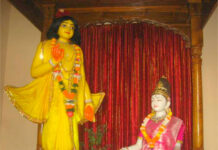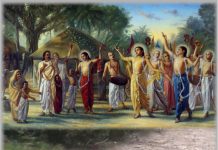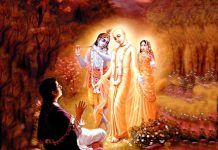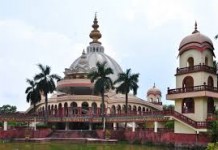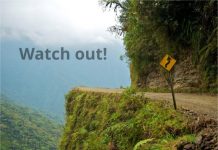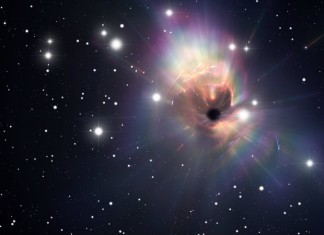In recent years we have observed a serious lack of trust in Indian media reports. The reasons for this development are threefold, with unethical journalism being the first one. The second reason is, the readers are getting smarter and have begun to realize that there exists something called paid news. The third one is the key reason, and although it inspires the first two, it remains unknown to the mass.
A few days back a friend of mine handed me an Indian newspaper clipping. I was sort of disgusted to see the way the content was presented. It addressed my decade-long quest as to how Indian media, or for that matter world media, actually functioned, who controlled it and why, almost always, good work of certain people went unpublished, or misinterpreted and distorted before the news reached the world.
Before we get into specifics, it is important to note that the sole purpose of this article is to highlight how Indian media has been misused and manipulated for decades, and how, leaving a handful of independent-minded newspapers, journalists, and bloggers, it is far from ethical journalism especially when it comes to reporting political affairs.
While it goes without saying that freedom of pen and presentation of thoughts are essential to healthy journalism, things get murky when analysis and reporting get intentionally overlapped.
Over the last few years I have read a good number of analysis, fact-sheets, and watched interviews and debates on the same subject matter but hardly did I believe that the media profession can get so corrupt. They don’t only misguide and hide facts; at times they even lie to the public. The disease has spread across the whole world and the sad part is, Indian media is no exception by any means.
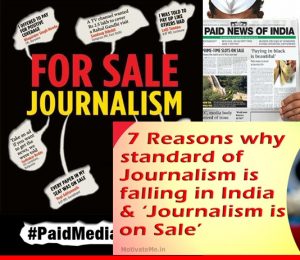
Knowing that India, at present, is fiercely influenced by the West, I suspected that Indian media may also be under the Western grip.
I googled “who controls media” and found some disturbing links. Disturbing not because the links pointed at a particular class as the controller of the world media, but due to the very fact that it was controlled by a specific interest group. How can there be transparency if news reports are censored and distorted to suit any specific interest?
From what I researched it seemed to be an almost established fact that despite counterarguments, the American media is controlled by a handful of corporate owners belonging to a particular faith. Going by figures available on the Internet, 96% of the world’s media is controlled by these people. Not only they control news media, they also allegedly control state affairs, including banking, politics, and even Hollywood.
No issues with that.
However, the following statement, reportedly made by an Israeli spokeswoman, Tzipora Menache, took me by surprise:
“You know very well, and the stupid Americans know equally well, that we control their government, irrespective of who sits in the White House. You see, I know it and you know it that no American president can be in a position to challenge us even if we do the unthinkable. What can they (Americans) do to us? We control congress, we control the media, we control show biz, and we control everything in America. In America you can criticize God, but you can’t criticize Israel…” (Source)
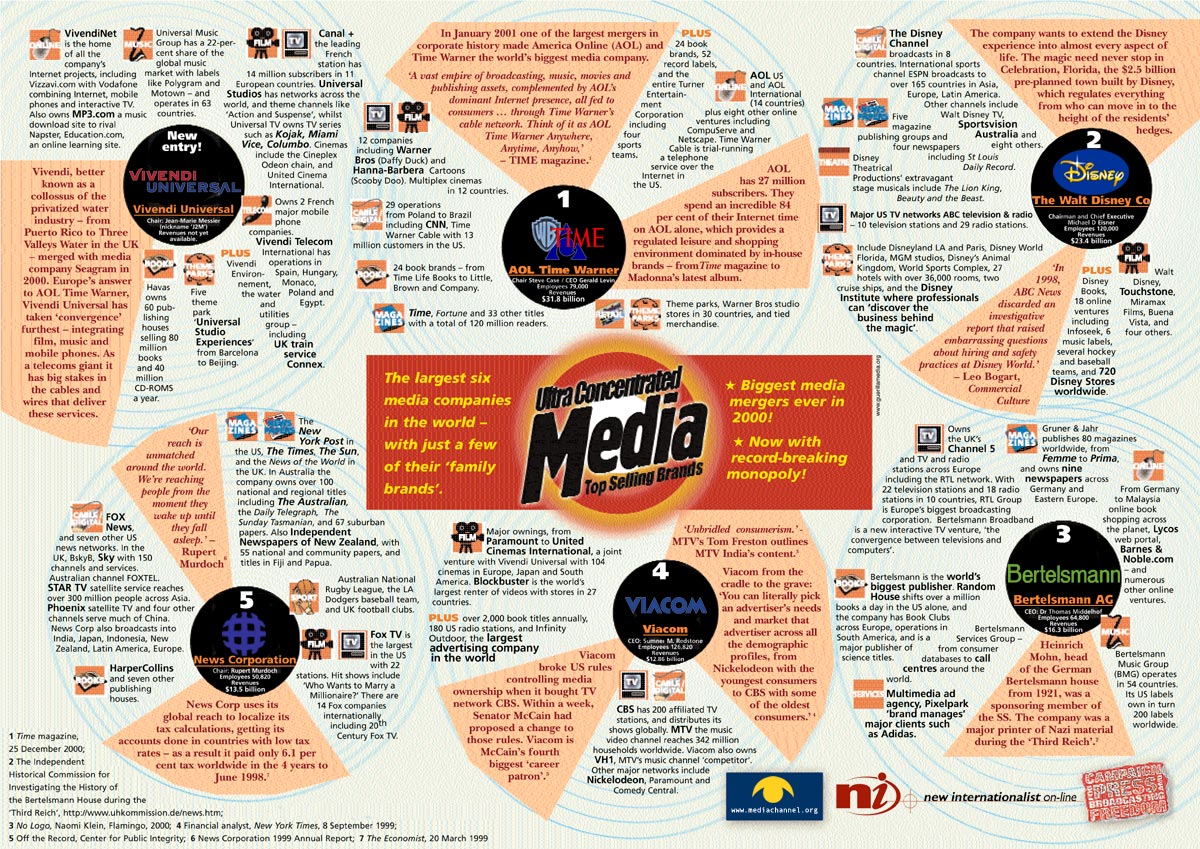
This video, addressed by David Duke, a Member of the Louisiana House of Representatives, made the same claim even clearer. And according to this article, there are 6 major media companies that exist today. There used to be 88. All these companies get their news from Reuters and the Associated Press. Reuters now owns the Associated Press and Mr. Rothschilds owns Reuters. That sums it all up. Knowing this, you would have fewer questions as to why the world media moves in a planned direction.
Next, I googled “who controls Indian media” and, wham! I was right, again! My reasons for discussing American media while discussing Indian media got justified. I found some compelling reports showing how Americans, and the West in general, controlled Indian media, and why they do so.
Dr. Gautam Sen, a distinguished writer at IndiaFacts.org, opines that the alleged oppression of minorities in India is the political bridgehead that modern evangelical organizations have entrenched in the public consciousness. This mechanism, executed through media, systematically distorts the reality and unceasingly fuels discontent within India.
“India happens to be one of the very few major countries in the world whose dominant media is controlled directly or indirectly by foreigners. The usurpation of control has actually been by Americans, much of it through surrogates of evangelical organisations that are in fact quasi-government agencies. Paradoxically, Leftist Indian political parties supposedly hostile to a US presence in India have been subdued with alacrity by these quasi-state religious agencies, which have been operating effectively in other parts of the world as well.”
“Viceroys to India in the decade before independence, Linlithgow, Wavell and Mountbatten are destined to prove prescient about its innate fractiousness. The alleged oppression of minorities is the political bridgehead that modern evangelical organisations have entrenched in the public consciousness, relentlessly distorting its reality and using it ruthlessly to fuel discontent within India. (https://apostlethomasindia.wordpress.com/about-us/who-controls-the-indian-media-gautam-sen/)
Take a look at the following list (source article*) of Indian media bosses and influencers and see for yourself who controls it. On reading, it will become clearer to you why, for example, despite Prime Minister Modi’s relentless work to improve everything India, his good work gets hardly highlighted, and why even a small error on his or his party’s part is blown out of proportion by media channels across India.
1. Hindustan Times – Shobhna Bhartia, owner and editor-in-chief of Hindustan Times is a Congress MP from Rajya Sabha.
2. Vinod Sharma, Hindustan Times Political Affairs editor, is essentially a Congress spokesman on all TV panel discussions.
3. Barkha Dutt and Vir Sanghvi, famous Congress stooges (and intermediaries for UPA allies) who were exposed in the Radiagate scandal, and are Congress spokespersons in their capacities as electronic media personalities, are the ones who write opinion and columns most frequently (once every week) on the editorial pages of HT. In return, Barkha and Sanghvi are rewarded with Padma Shrees and other compensation by the Nehru dynasty or Congress party.
4. NDTV’s promoters are Prannoy Roy and Radhika Roy. Radhika’s sister Brinda Karat is a famous CPM leader (well known for anti-Baba Ramdev views) and Brinda’s husband Prakash Karat is the CPM, General Secretary (well known for preferring Congress over BJP). And Prannoy Roy’s first cousin is the famous far-leftist pro-Maoist-Naxalite pro-Kashmiri-terrorists “intellectual” Arundhati Suzanna Roy.
5. NDTV’s Sonia Singh is the wife of Uttar Pradesh Congress MP, Union minister and ex-princely state ruler, Mr. R. P. N. Singh, who is one of the fastest rising stars in the Congress party. If you remember, Sonia Singh is a very high-profile anchor on NDTV whose anti-BJP views are followed by the Digvijay Singh.
6. NDTV’s Nidhi Razdan, a high-profile anchor, is known for her friendship with Omar Abdullah, and is famous for her Congress bias.
7. CNN-IBN : Rajdeep Sardesai’s wife and co-promoter of CNN-IBN, Sagarika Ghose, who anchors Face the Nation and is famous journalist of CNN-IBN (her husband is the owner-editor-in-chief) are famous Congress stooges. Sagarika’s father Bhaskar Ghose was made the chief of Prasar Bharati (Doordarshan) during Indira and Rajiv regimes. Bhaskar Ghose was well-known for personal loyalty to the Nehru dynasty, and now his daughter and son-in-law are running their own channel running Congress propaganda.
8. News24 Hindi media channel: Little known but owned by ex-journalist and editor Rajiv Shukla, famous Congress MP in Rajya Sabha, Union minister, industrialist, BCCI vice president and IPL chairman.
9. Lokmat (and IBN Lokmat): It’s a Marathi newspaper (and channel). Owner and editors-in-chief are the brothers, Vijay Darda (Congress MP) and Rajendra Darda (Congress MLA in Maharashtra, and minister in state govt).
10. Vinod Mehta** – Outlook editor has been well known to take anti-BJP stand.
(*This list may need some updates. **A few years back Krishna Prasad officially replaced Vinod Mehta, who died in 2015)
Mr. K A Krishna Rao, a renowned author at WHN, goes on record stating, “personal relationships have been built, blackmail-worthy secrets have been recorded, monumental wealth has been accumulated all by the one single Nehru dynasty (and its family-business-cum-political-party Congress) that helps it maintain its tight iron grip over not just the entire Indian mainstream media, but also deep into our bureaucracy, our governmental institutions, and even our journalism and mass media, colleges and graduation schools. I have not even scratched the surface of the network of family and personal relationships through which the Nehru dynasty has completely dominated and controlled the entire intellectual, historian and journalist landscape of India. And we haven’t even talked about the monumental wealth or the blackmailing secrets. All because the one single dynasty got to rule over India for 60 years uninterrupted. It matters a LOT. The typical JNU Nehruvian communist left-libbers ideologues have really perpetrated some kind of stranglehold on India’s journalism, media and intellectual space. Almost all BJP or even neutral journalists have been slowly thrown out of their jobs due to pressure from the Congress and the Nehru family.” (http://www.worldhindunews.com/…/indian-media-in-bed-with-politicians-k-a-krishna-rao/
No surprise a tiny event like JNU student’s arrest made such an uproar in the Indian media and the world when all major newspapers carried a strikingly identical release. Not only that, in order to highlight the so-called “intolerance” in India by the Modi government, some prominent scholars and intellectuals returned their national awards leaving their hard-earned reputation at stake. Why? Because they had to align with those who had promoted them, the media owners.
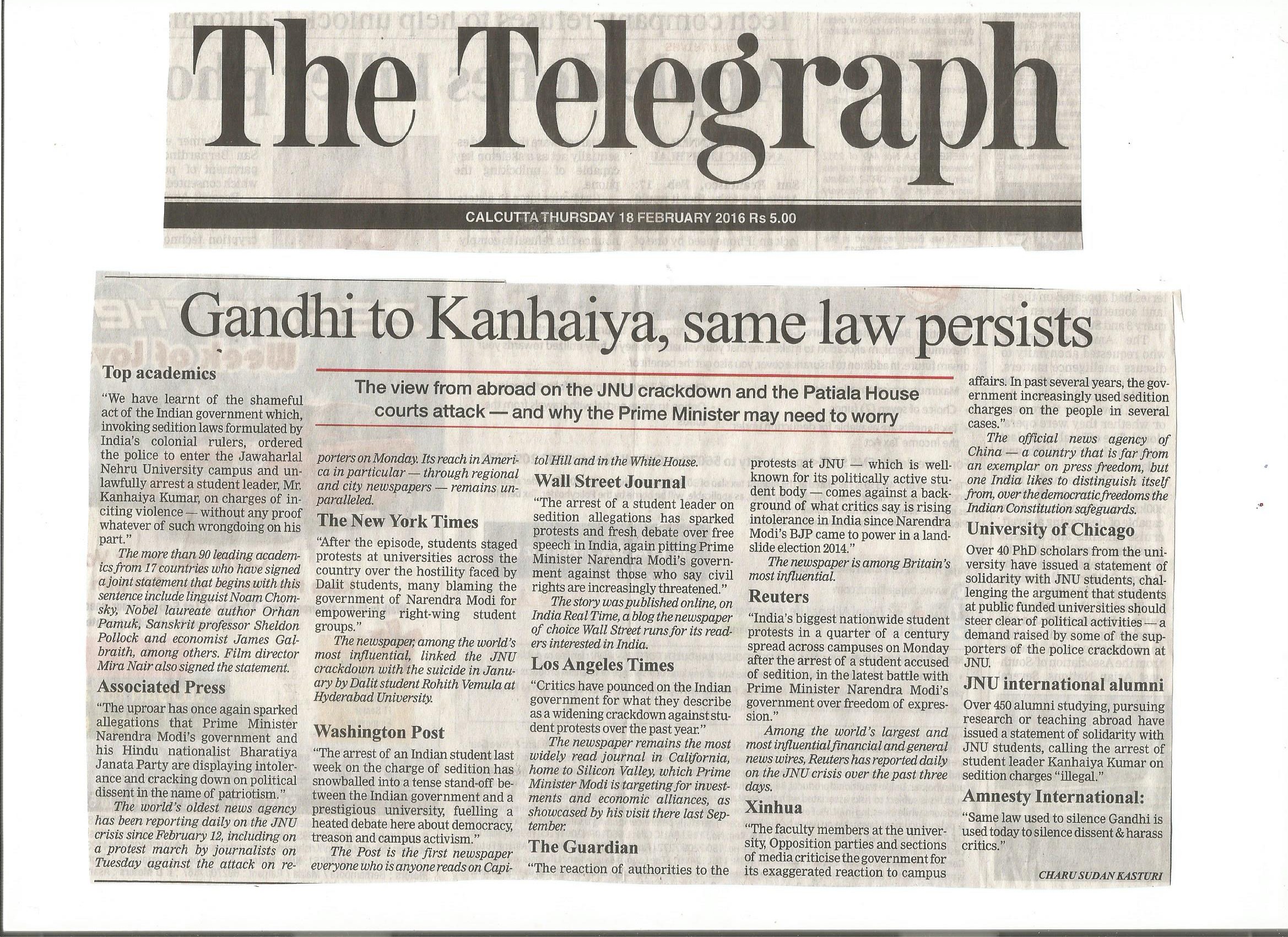
When the Congress party essentially owns and controls every single mainstream media house in India, including Hindustan Times, The Times of India, NDTV, CNN-IBN, The Hindu, Tehelka, Outlook, Aajtak, News24, Amar Ujala etc., what hope is there for Indian media to be transparent and unbias?
This makes sense if we analyze the ongoing media trend of labeling anything Modi as Hindu fanaticism and anything anti-Modi as secularism. This is a gross misinterpretation of otherwise verifiable facts.
Minhaz Merchant has to say this in his article Why India no longer trusts anti-Modi media:
“Sonia Gandhi was among the first in the Congress to spot Narendra Modi’s potential as a threat to the Congress’ political hegemony. Her maut ka saudagar invective in 2007 sparked a chain of abuse that lowered standards of political discourse which have today become mainstream. A campaign of vilification was launched against Modi by the Congress in 2013 which saw him as an existential threat – a fear that would be borne out in May 2014 when the Congress plunged from 206 Lok Sabha seats to 44.
It was now that the mainstream media lost the plot. A large section had been co-opted by the Congress and by 2013 was fully embedded into its ecosystem. Some columnists were so obsessively – and often viciously – anti-Modi that they achieved three unintended objectives: one, they eroded their own credibility; two, they generated unexpected support for Modi among readers who felt he was being unfairly maligned; and three, they caused widespread revulsion in the public for mainstream media.
Television fell victim as well. Anchors took sides, again violating professionalism and journalistic integrity. Foreign media took the cue from biased, politically affiliated Indian journalists. The New York Times, The Guardian, The Washington Post and The Economist carried stories that failed the test of neutral journalism. Facts were mangled and interpretations distorted. The victim: the newspapers’ own reputation. Some Indian television networks are so viscerally anti-Modi today that they no longer attempt to hide their bias beneath a veneer of journalistic professionalism. (http://www.dailyo.in/politics/modi-government-indian-media…congress-bjp-upa/story/1/7638.html)
Leaving politics aside, the biggest question is, why does Indian media have to go against Modi even when he works in India’s interest? It is impossible that they are unaware of national interest. What keeps them from acknowledging his good work when even foreign medias are, in a way, open to praise him? Has it only to do with power or also religions?
In Swami Jyotirmayananda’s opinion, “There are many people in India who have no doubt that the so-called ‘secular’ print and electronic media, at least a dominant section among them, knowingly or unknowingly, is playing a very adverse and prejudiced role, when it comes to the reporting of the Hindu point of view. Suppressing or misrepresenting tactics are being liberally used along with admonitions and ridicules of the Hindus, ‘Hindutva’, and the Hindu Dharma. At the same time, this secular section appears to support the anti-Hindu forces in the country, which are active with their alien and subversive ideologies. In essence, it has come to mean that ‘secularism’ is nothing but opposition to Hindus, Hindustan, Hindutva and the Hindu Dharma. This is quite ridiculous in a country that is predominantly Hindu in its composition and character. This situation is agonizing to many and confusing to many more, since they would not get a true picture of what is going on in the country because of the prejudice of the media.” This analysis stands valid considering almost all major media houses in India are owned and controlled by non-Hindu groups.
So what is the guarantee that the content written and quoted in this article is also not a victim of the same biased media practice? What if I am also part of that Indian media that I am raising concern about? Well, that only you can decide, but I would suggest you do an extensive research and study the mindsets and backgrounds of the authors and owners of media houses before coming to any conclusion. Besides, applying your own discrimination power and listening to your conscience can help you get a more accurate conclusion. Let me add that I have no political affiliation with anyone nor do I get paid for writing articles. I do it as a service, not only to India but to humanity at large. And I write after doing my homework.
Regardless of who controls the media, the main concern is, what they publish and what they don’t. Today media has become a tool for spreading misinformation and godless philosophies. Nations and civilizations have fallen due to unethical media practices. Under the circumstances, India, having its root in Vedic civilization, has the responsibility to rescue mankind from the clutches of falsity and atheism, which is the main cause behind the prevailing unrest in the world. Indian media houses can play a vital role in achieving this. The so-called secularism, or anti-religion propaganda, regardless of which religion, needs to be uprooted from the world if mankind is to see peace and happiness.
God is the owner of all that exists. This includes media. The ether through which the Internet, televisions and radio waves travel, and the trees providing papers for the print media, are all God’s creation. No man created it. Therefore, the claim of any man, corporate house or nation to have proprietorship over any of the public media is an illusion. For this reason, the best use of media is to glorify God and make more people aware of His omnipotence. All other attempts will fail, today or tomorrow.
Wisdom is that which increases when shared. Today, in the age of technology, there are innumerable opportunities to share wisdom. Indian media can do wonders in changing the world for good. The correct application of human intelligence is to utilize it in spreading the message of God, not of some selfish mortal beings.


